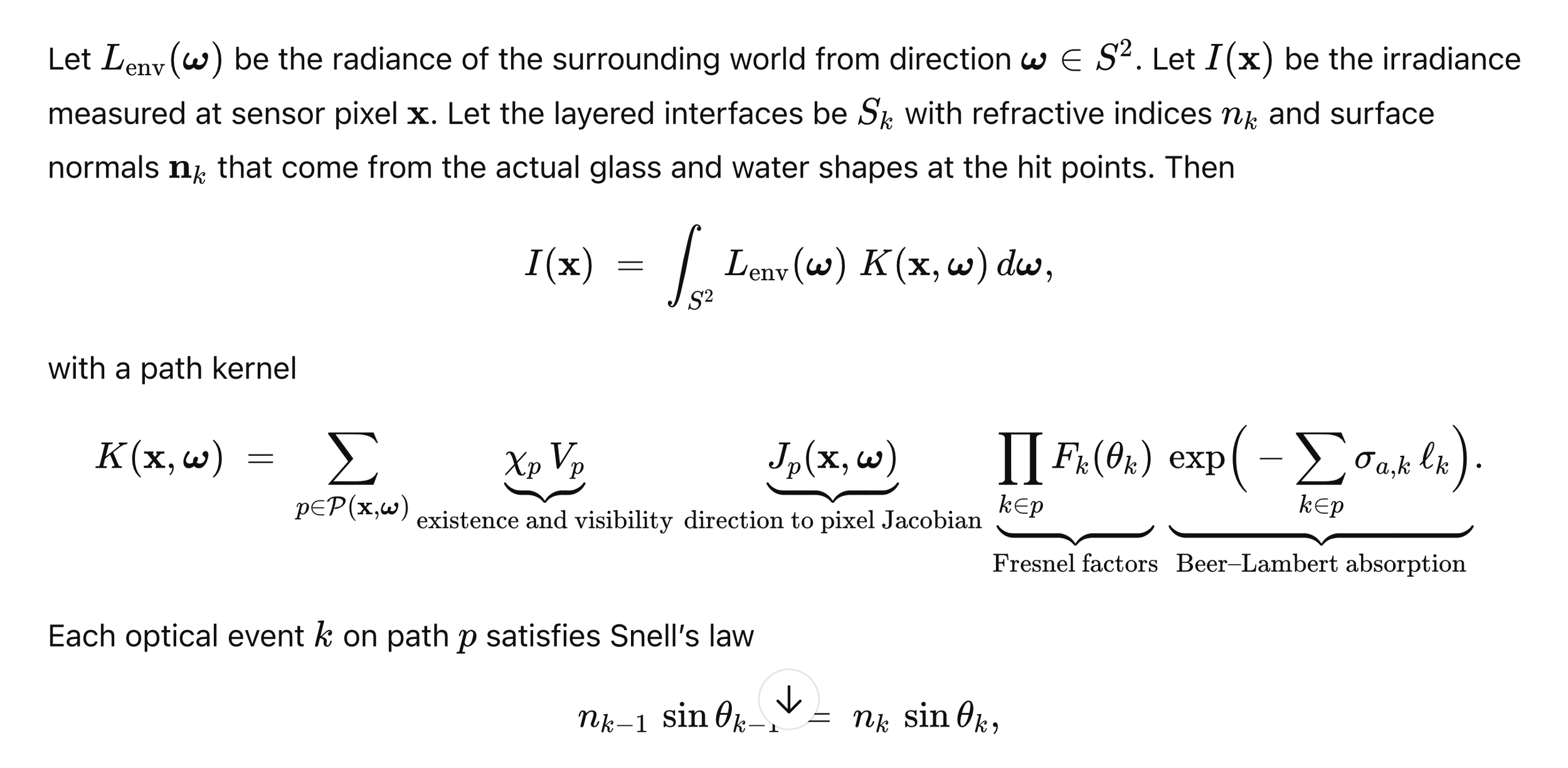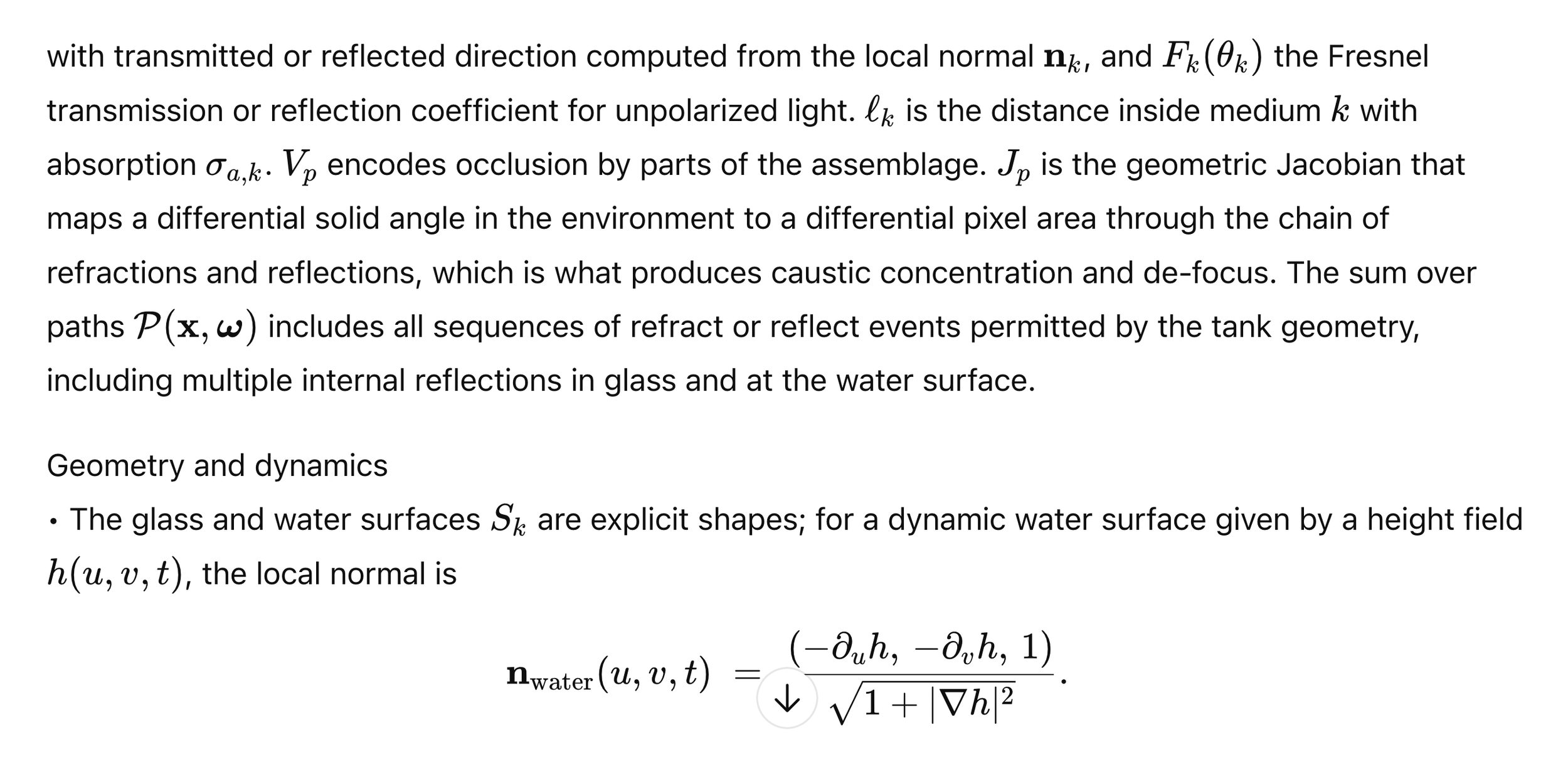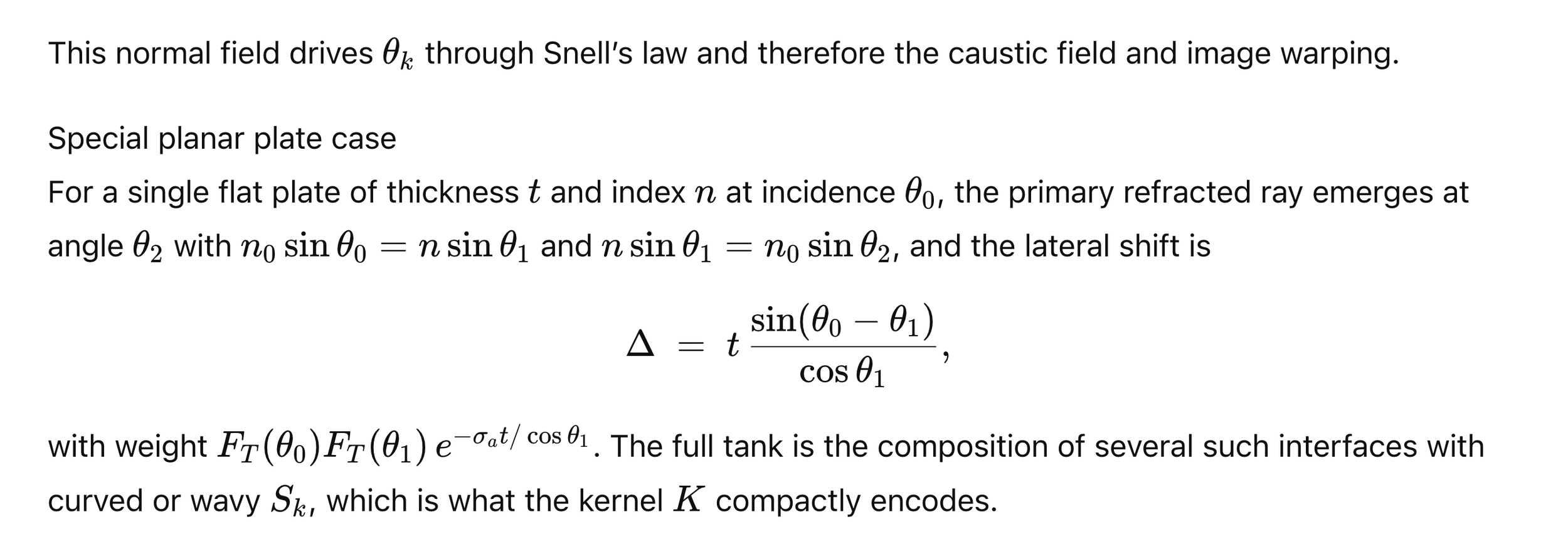A Mathematical and Technical Analysis of the [(Glass - Water - Light) Assemblage], in Relation to the Visual and Temporal Environment
Abstract
A mathematical and technical analysis that articulates the [(glass – water – light) assemblage] expression, as exemplified in the installation Water on Water × 5, while integrating environmental imagery reflected and refracted through the lens of the construction, incorporating Snell’s law, path mapping, Fresnel modulation, environmental coupling, and temporal variability to reveal the dynamic interplay of material, light, and perception.
We can call this a “[(Glass - Water - Light) Assemblage] transform” — from site radiance, to camera image, through a layered refractive micro-architecture. It captures Snell refraction, Fresnel energy splitting, absorption, multiple bounces, and the live imprint of the surrounding imagery on the glass water construction.
These photographs make the optical condition described above immediately legible. They show how the assemblage behaves as both a refractive instrument and a perceptual register of its environment.
You can see:
Snell-field structure: Each glass–water interface bends and layers the horizon differently, so the environment is encoded as a stack of shifted visual strata. The changing daylight alters refraction angles, making the geometry act like a variable-index lens array.
Fresnel modulation: Under oblique light (especially in the second image), the surfaces flash with internal reflections and thin-film interference at the air–glass–water boundaries, articulating energy transitions rather than solid form.
Environmental coupling: The surrounding water becomes both context and participant. Its surface ripples scatter and re-enter the glass volumes, so the piece functions as a recursive optical loop — river light refracted through contained water back into river.
Temporal variability: The difference between overcast and illuminated conditions across the three images reveals the temporal equation implicit in the work — environmental radiance and angle of incidence modulate the internal luminous field.
In short, these images demonstrate the mathematical and phenomenological principles — the Snell refractive mapping, Fresnel weighting, and environmental radiance integral — in visible, experiential form.
The following is a layman’s explanation of the mathematical analysis — translating the technical and mathematical language into clear, intuitive terms that describe what’s happening in the glass - water - light works, and what the equations are expressing.
Understanding the “Glass–Water–Light” Equation
The text and equations describe how light moves through the glass-and-water structures and how they visually transform the surrounding world. The math isn’t there for calculation — it’s a way of precisely describing how perception, material, and environment interact.
1. The idea in plain language
These works captures the behavior of light as it passes through layers of air, glass, and water, and then back out into air. The environment around the sculpture — sky, water, trees, clouds — isn’t just reflected on its surface; it becomes part of the piece itself. The sculpture is both an optical device and a perceptual field, reorganizing the surrounding world into new patterns of light and color.
2. What the main equation means
The main equation says that every image we see from the sculpture is created by adding up (integrating) all the light coming from every direction in the environment, each piece of light transformed by the way it travels through the sculpture.
Think of it like this:
The environment is sending out light in every direction.
The sculpture — through its glass and water — bends, filters, and redirects that light.
The eye or camera receives a version of the environment that has been remade by those transformations.
That’s what the integral (∫) represents: the sum of all these influences across the visual field.
3. What the “kernel” describes
The “kernel” is a mathematical way of describing how each possible light path is affected:
Some rays pass straight through.
Some bounce internally between glass and water.
Some are partially reflected.
Some are absorbed or colored slightly by the materials.
The kernel tracks all of those events and how they modify the light’s intensity, direction, and color before it reaches the viewer.
4. Snell’s Law and the behavior of light
Snell’s Law governs how light bends when it crosses from one medium to another — say, from air into glass or from glass into water. The amount of bending depends on the refractive index (how dense the material is optically). That’s why the boundaries in the sculptures cause lines, reflections, and the horizon to shift and distort.
5. Fresnel effects and absorption
Fresnel effects describe how much light reflects versus how much transmits at each boundary. This is what causes the flickering, luminous edges you see on the glass as the viewing angle changes.
Absorption (the Beer–Lambert part) describes how light slightly diminishes or changes color as it travels through the material — why thicker glass appears deeper or more saturated.
6. Geometry and motion
The equations also acknowledge that the sculpture’s surfaces — especially water — are alive. Tiny ripples alter the angles of reflection and refraction continuously, creating shifting caustic patterns. The normal vectors (surface directions) constantly change, turning the whole structure into a dynamic optical lens.
7. The big picture
Altogether, this framework describes the sculpture as a transformer of perception. The environment enters as raw light and emerges reorganized into a living image — an evolving synthesis of matter and reflection.
The math shows that the work isn’t static; it’s a living computation between nature and geometry, constantly translating the world into new visible structures.
8. The closing insight
The final statement means that the photographs of the work make the physics visible: you can see Snell’s law at work in the bending of reflections, see Fresnel weighting in the glows and gleams at the edges, and see the environment’s radiance integrated and transformed by the structure.
In essence, these sculptures demonstrate — visibly and experientially — the same principles that physicists describe mathematically: light behaving as both a physical and perceptual phenomenon.
This analysis was generated by a lengthy conversation between the artist and artificial intelligence.



